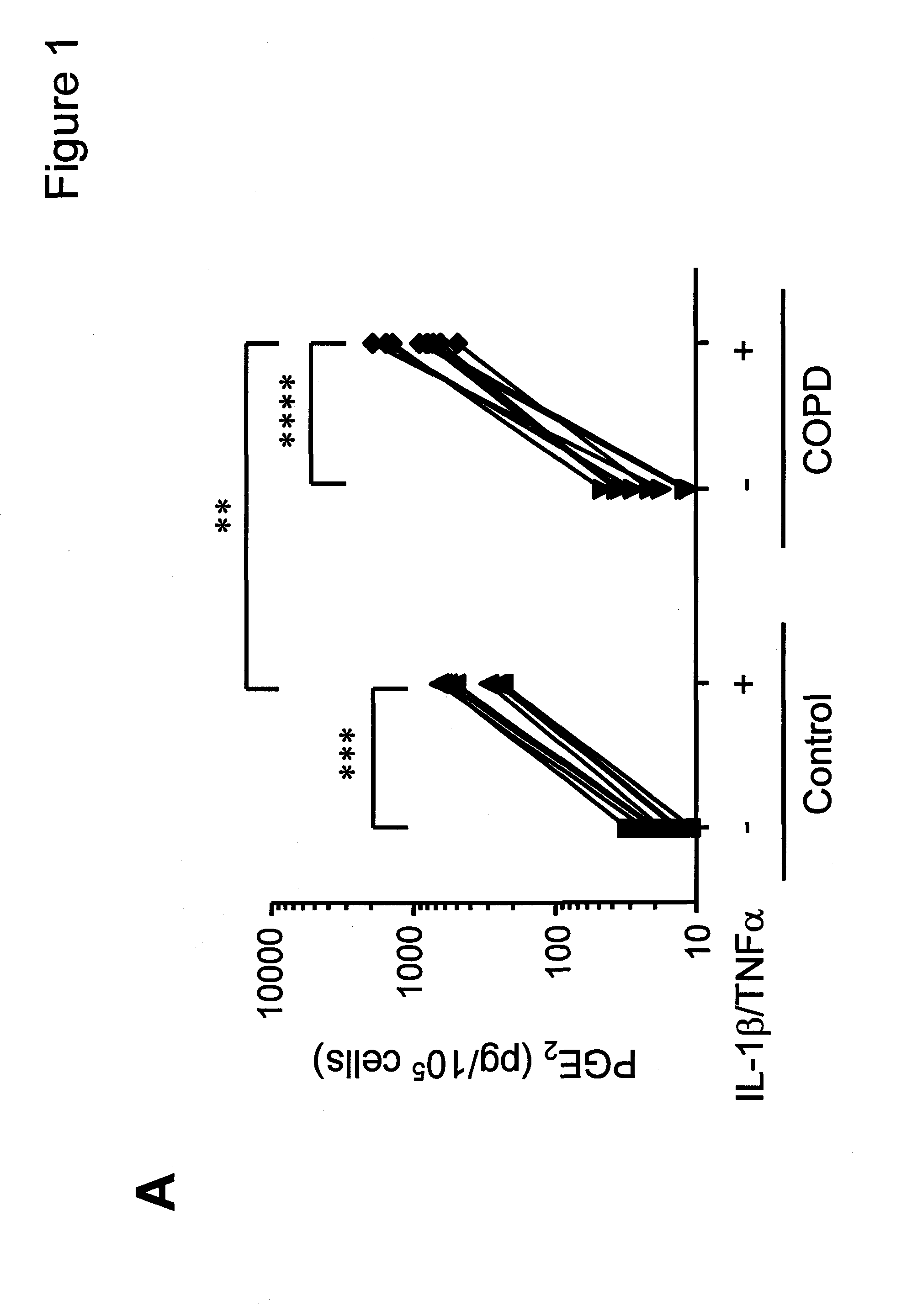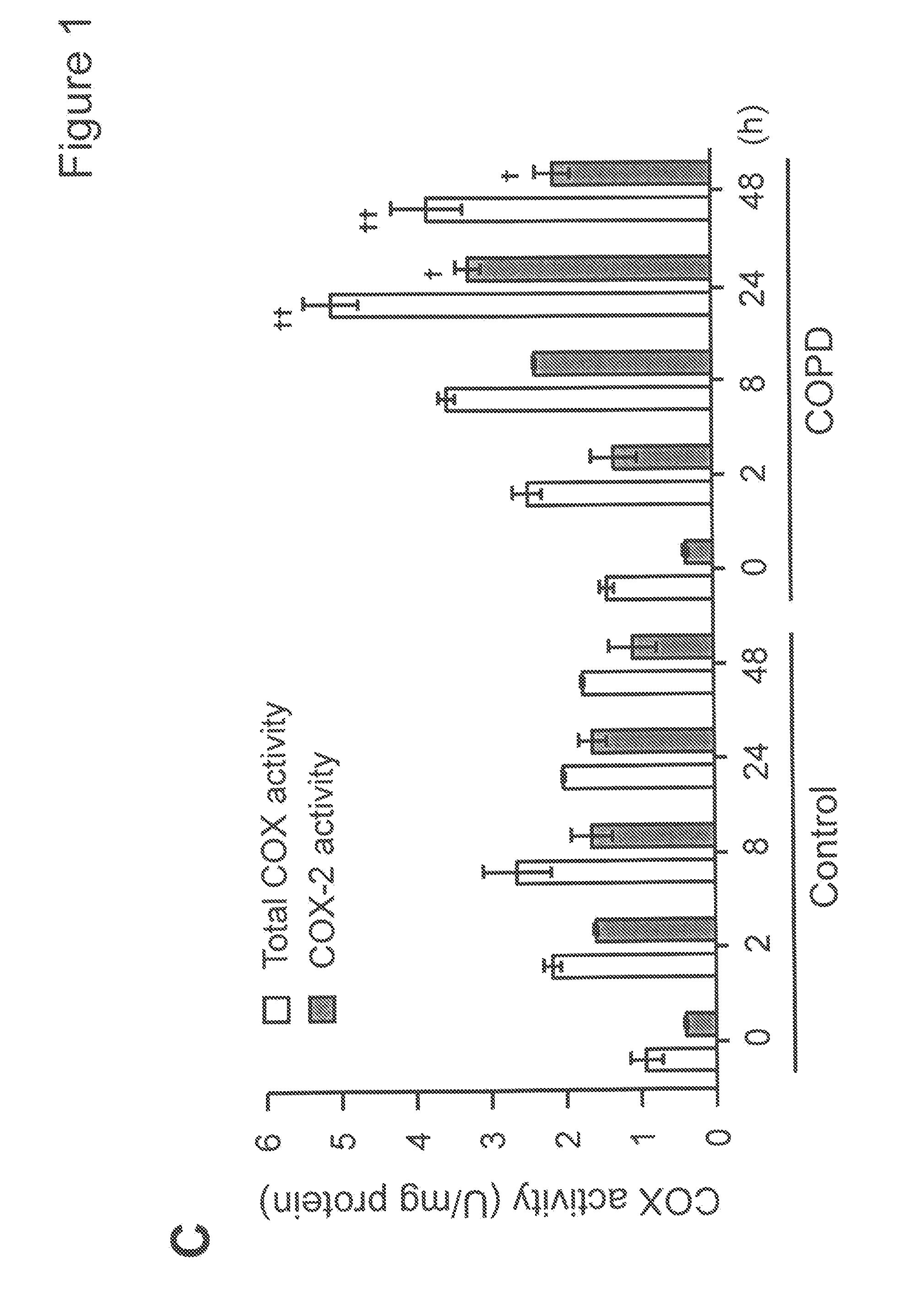Compositions and methods for the diagnosis and treatment of inflammatory disorders and fibrotic disease
a technology for fibroblasts and inflammatory disorders, applied in the field of pulmonary diseases and inflammation, can solve the problems of copd patients' fibroblasts deficient in a number of repair functions, no currently available medical therapy can restore lung function, etc., and achieve the effects of decreasing spla2 protein production, and increasing cox-2 mrna stability
- Summary
- Abstract
- Description
- Claims
- Application Information
AI Technical Summary
Benefits of technology
Problems solved by technology
Method used
Image
Examples
example 1
Reduced microRNA-146a Increases COX-2 Expression and PGE2 Production in COPD Fibroblasts
[0157]Alterations in tissue structure compromise lung function and directly lead to morbidity and mortality in chronic lung disease. Therapeutic modulation of tissue repair and remodeling processes offers an opportunity to slow the progression of chronic lung disease and, potentially, to restore lung function. In chronic obstructive pulmonary disease (COPD), several tissue lesions are important. In the small airways, fibrosis with airway narrowing is a major cause of airflow limitation. Deeper in the lungs, in the alveolar structures, destruction of lung parenchyma is the defining feature of emphysema. Inhibition of fibrosis, therefore, would be appealing to treat the airway component of COPD. However, in the alveolar structures, repair appears to be deficient, and stimulation of repair is appealing. Thus, an ideal treatment that targets tissue remodeling in COPD should inhibit fibrotic repair in...
example 2
Differential Modulation of PGE Biosynthesis in Airway vs. Alveolar Fibroblasts
[0170]Several structural alterations contribute to the airflow limitation that characterizes COPD. Most important among these are two processes: 1) fibrosis and narrowing of small airways; and 2) destruction of alveolar walls, which is the defining feature of emphysema. Both lesions are believed to result from damage induced by cigarette smoking or other exposures that is amplified by the inflammatory response.
[0171]Airway fibrosis, like other forms of fibrosis, results from the accumulation and activation of mesenchymal cells, particularly fibroblasts or myofibroblasts, that produce and remodel extra-cellular matrix. Emphysema, in contrast, results from tissue destruction that exceeds the capacity to repair resulting in net tissue loss. These two lesions, therefore, reflect two nearly opposite consequences of tissue injury: over-exuberant repair and inadequate repair.
[0172]Inhibition of mesenchymal cell r...
example 3
Role of miR-146a in Modulation of TGF-β1-Mediated Fibroblast Repair
[0206]Chronic inflammation leads to tissue damage and is believed to contribute to structural damage in lung disease. Insufficient repair of alveolar structures may contribute to the development of emphysema while over exuberant repair of small airways may result in peri-bronchial fibrosis. Lung fibroblasts play an important role in tissue repair following the airway inflammation, which is believed to be directed by TGF-β1 signaling, in part, through a family of Smad proteins: Smad2, 3 and 4. MiR-146a, an inflammation responsive microRNA, is dramatically up regulated in lung fibroblasts in response to the pro-inflammatory cytokines, IL-1β and TNF-α, and has homologies with Smad2, 3 and 4. This suggests that miR-146a mediates interactions between IL-1β and TNF-α and TGF-β1. Supporting this concept, our initial studies (disclosed herein) demonstrate that transfection of a miR-146a mimic into human fetal lung fibroblast...
PUM
| Property | Measurement | Unit |
|---|---|---|
| Tm | aaaaa | aaaaa |
| temperature | aaaaa | aaaaa |
| Tm | aaaaa | aaaaa |
Abstract
Description
Claims
Application Information
 Login to View More
Login to View More - R&D
- Intellectual Property
- Life Sciences
- Materials
- Tech Scout
- Unparalleled Data Quality
- Higher Quality Content
- 60% Fewer Hallucinations
Browse by: Latest US Patents, China's latest patents, Technical Efficacy Thesaurus, Application Domain, Technology Topic, Popular Technical Reports.
© 2025 PatSnap. All rights reserved.Legal|Privacy policy|Modern Slavery Act Transparency Statement|Sitemap|About US| Contact US: help@patsnap.com



